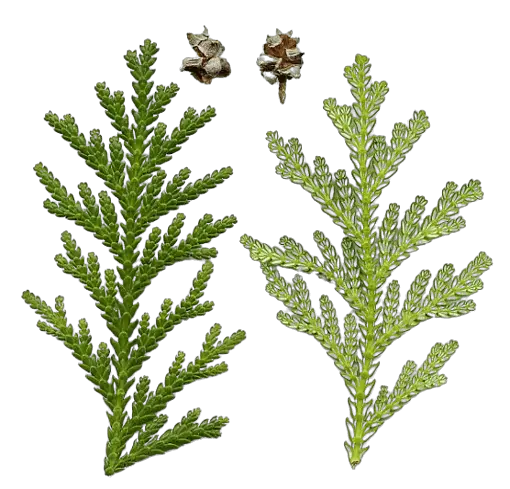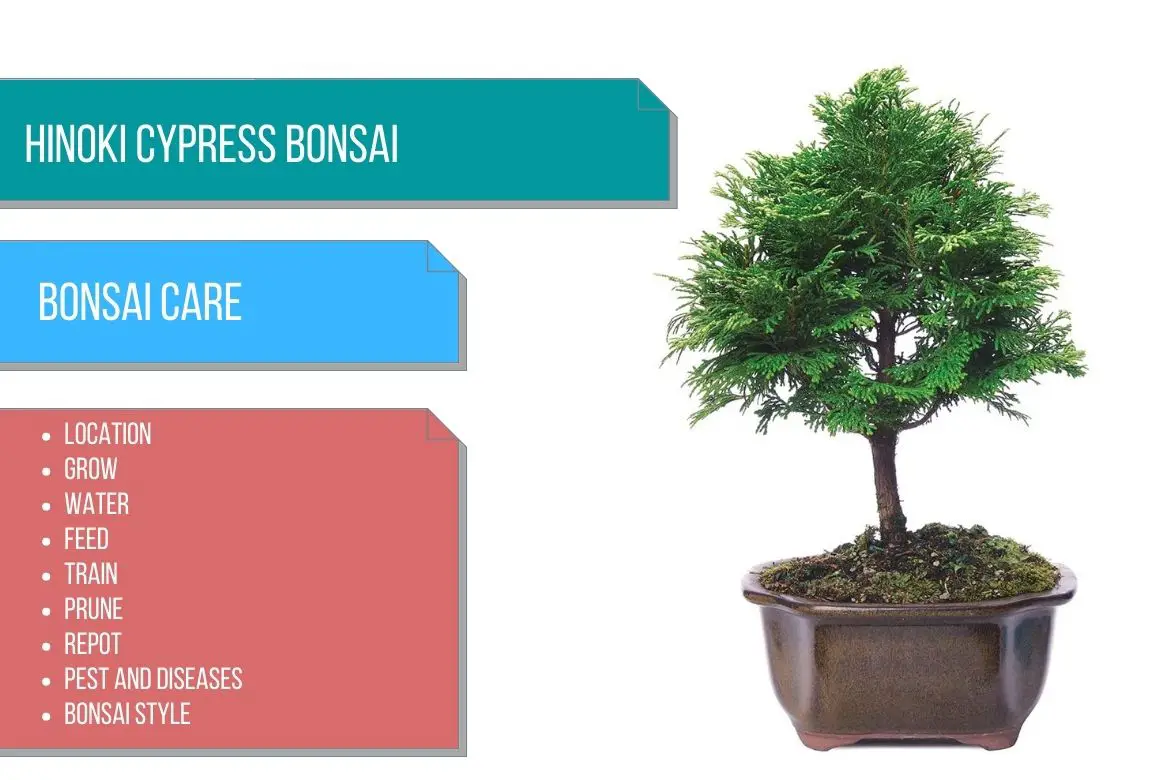
Hinoki Cypress
(Chamaecyparis obtusa)
Country of Origin : Japan
Bonsai Styles : Formal upright, informal upright, twin trunk
Zone : 4 – 8
Hinoki cypress, Chamaecyparis obtusa, is the most commonly cultivated bonsai species.
Chamaecyparis obtusa is a tough, long-lived evergreen native to Japan and North America that usually grows in conical or columnar shapes.
Leaves on their flat, fan-shaped branches look like scales.
Upon crushing the hinoki cypress’s leaves, they emit a sweet aroma. Their leaves are blunt, deep green, scale-like, and have silver-white or silver-blue undersides.
Brown and flaky, the bark presents a very attractive appearance and can be peeled to reveal rich, dark reddish-brown coloring.
It is a slow-growing evergreen tree that reaches an estimated height of 130 feet (40 meter) when growing in the wild.
Hinoki cypress trees typically have flame-shaped profiles, however they take on a broad and almost dome-shaped appearance as they mature, with dense foliage covering bare and exposed branches.
In essence, this is what most hinoki bonsai attempt to convey, but their slow growth makes it difficult to find a good hinoki cypress bonsai tree specimen. Therefore making a good bonsai specimen of this tree relatively expensive.
Along with Chamoecyparis obtusa, there are other varieties of Chamoecyparis which are also used to make bonsai tree.
- Chamoecyparis pisifera– This variety is also called as Sawara cypress. It has light feathery, sharp or soft needles. The needles are steel-blue to gold in color. It mostly has bright green foliage.
- Chamoecyparis ‘Yatsubusa‘ – This is a dwarf variety of Chamoecyparis used to make bonsai trees. It is a Japanese dwarf variety. It is relatively compact and has a cleaner habit of growth.
- Chamoecyparis ‘Nana Gracilis‘ – This is also a dwarf variety of Chamoecyparis used to make bonsai trees. This variety can be commonly found in Europe.
Several flat, fan-shaped sprays of evergreen foliage surround Hinoki Cypress tree’s shoot, and its leaves are tiny, scale-like.


Best location to keep Hinoki Cypress Bonsai
Cypress trees are hardy in temperate zone. Throughout the growing season, Cypress plants do well in full sun.
When grown in bonsai containers, hinoki cypresses do better in semi-shade during the hottest months of the year, despite tolerating hot sun in the wild.
As long as the tree is not exposed to dry winds, Hinoki can survive frozen roots for a considerable amount of time.
While the waxy coating seems to provide some protection from the wind, it is not enough to provide proper protection for containerized plants.
However, even long after the tree has died, the waxy nature of the foliage makes the tree look healthy.
Make sure the hinoki cypress bonsai tree is kept in temperatures above 23 °F (-5 °C) in cold weather. At this time, keep the bonsai tree in frost-free shed or greenhouse.
Propagation of Hinoki Cypress
Hinoki Cypress can be planted via stem cuttings. Summer or fall are the best times to sow cuttings in sharp sand.
Hinoki Cypress can also be planted using grafting. Late summer is a preferred time for grafting. This doesn’t apply to Yatsubusa variety.
Watering Hinoki Cypress Bonsai
The roots of Hinoki cypress will suffer from dryness, and once drought has damaged them, they are unlikely to recover.
Keep your hinoki cypress bonsai tree well-watered all year, especially in the summer, and avoid letting it become waterlogged.
From late spring to early fall, spray foliage daily with a fine mist. However, make sure that the leaves are not scorched by sun because of water droplets.
In winters keep the bonsai soil moist.
Wiring Hinoki Cypress Bonsai
Spring or midsummer is the best time to wire your hinoki cypress bonsai tree.
Be careful not to trap any foliage under the wire.
It is not recommended to leave the wires in place longer than 10 months.
You may need to replace them if necessary.
Pruning Hinoki Cypress Bonsai
When to prune Hinoki Cypress bonsai?
How to prune Hinoki Cypress bonsai?
Pruning branches and trimming old twigs should be done in summer.
This is the time when wounds heal quicker and the foliage regrows more rapidly.
Pinching Hinoki Cypress Bonsai
Throughout the growing season, pinch out the tops of your foliage sprays. These overextending tips spoil the look of the hinoki cypress bonsai tree.
If necessary, repeat the process, followed by regular spraying for one week after each pinching operation.
Pull off all the tips from a cluster of shoot ends by holding them between your thumb and forefinger. Your foliage shape will be neat and even with this technique.
Repotting Hinoki Cypress Bonsai
When to repot Hinoki Cypress bonsai?
Younger specimen of hinoki cypress bonsai tree can be repotted in 2 – 3 years.
Older specimen (almost or more than 10 years old) of hinoki cypress bonsai tree can be repotted in almost 5 years.
early to Mid spring is a good time to repot the bonsai tree.
You can also practice repotting the Chamaecyparis bonsai tree when the tree is potbound.
Use a basic soil mix or mix.
OR
You can also use a bonsai soil mix with one part peat, one part sharp sand and one part loam. (1:1:1)
OR
Or you can use 40% grit and 60% organic matter.
You can also use akadama. However, make sure that it is never kept dry.
Must Read: Bonsai Soil Recipes
Feeding Hinoki Cypress Bonsai
There are multiple ways you can practice feeding your Hinoki Cypress Bonsai tree.
Spring through fall, use a balanced feed of half strength. In late fall, add a nitrogen-free feed.
OR
From spring through late summer, feed a balanced feed. In early fall, feed a nitrogen-free feed.
Preparing for spring with a dose of balanced, slow-release fertilizer during winter will help. Half the strength is fine.
OR
During the spring, sprinkle a high-nitrogen fertilizer, followed by two more applications of a general fertilizer in summer.
Diseases and pest of Hinoki Cypress Bonsai
Fungal attacks on Hinoki Cypress Bonsai tree are uncommon.
Spider mites that live in the dense inner branches are attracted to the dry, protected environment of Hinoki Cypress Bonsai tree, and can soon kill off large areas of foliage if not addressed quickly.
Scale insects can damage these trees, but they can be controlled either by hand or by using a systemic insecticide if they are noticed quickly enough.
Hinoki Cypress bonsai care
The shape of an established hinoki cypress bonsai tree is easy to maintain as it generally has dense foliage.
Care should be taken when wiring or thinning out old twigs on hinoki cypress because the foliage fans are very easily dislodged.
For first-time growers, these plants tend to lose a lot of their old foliage in autumn, which can cause a lot of confusion. In this case, all you need to do is remove the brown foliage by hand, and the tree will look great.
The best way to keep it healthy in summer is to spray it twice a day with clean water.
One disadvantage is that the Chamaecyparis obtusa bonsai tree is generally unable to generate new shoots from old wood. Hence, you should always remove the dead leaves from the underside of the branches, so that the inner part of the bonsai tree can breath and receive appropriate light to grow. Also hard pinch the new shoots. By combining these two practices, the growth of small shoots in minor branch intersections will be promoted.
It is best for conifers like Chamaecyparis to have a generous amount of space between branches, so they remain healthy. Consequently, the inner foliage is able to receive ample light, without which it would ultimately perish.
Lot of care has to be taken when trying to grow hinoki cypress bonsai tree in indoor conditions.
What to look for when buying Hinoki Cypress Bonsai
Bonsai enthusiasts are often interested in the Hinoki cypress bonsai tree, however it is sometimes hard to find.
In Japan, fine specimens of hinoki bonsai are highly prized both in forest plantings bonsai and as single-tree bonsai displays.
Hinoki that are exported are typically small and rounded, which is contrary to their natural shape.
It is possible to find authentic, conical specimens, but they are far more expensive due to the species’ slow growth rate.
However, it is still worth trying a hinoki cypress bonsai tree that is more reasonably priced.
You should look for a hinoki cypress bonsai tree with a thick trunk and attractive roots on the surface. As, plenty of henoki bonsai specimens are mere root cuttings with dense foliage.
Make sure the trunk of the tree continues right to the top of the canopy.
Make sure the branches or future branches are distributed evenly and don’t emerge from a common origin.

